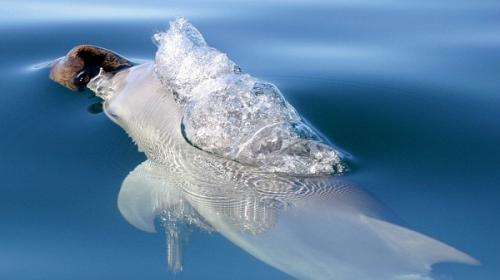Some populations of Indo-Pacific bottlenose dolphins (Tursiops aduncus) use a sponge over their beaks when foraging to protect them from sharp rocks, stingray barbs and fish spines. Credit: Simon Allen
Indo-Pacific bottlenose dolphins that use sponges as hunting tools are eating different foods to those who do not and the unique behaviour could have shaped the genetic makeup of the population, according to two new studies at Shark Bay.
In the first study, marine biologists took blubber samples from "spongers"—dolphins who use a sponge over their beaks when foraging to protect them from sharp rocks, stingray barbs and fish spines—and compared them to "non-spongers".
They found the fatty acid profiles of the spongers was significantly different to other dolphins in the same area, suggesting animals that use a sponge as a tool have a completely different diet.
Murdoch University researcher and co-author Simon Allen says it is likely spongers eat fish without swim bladders such as sand perch and gobies as well as cuttlefish and other small cephalopods.
These fish would usually be difficult for the dolphins to detect using echolocation but could be found using a sponge to probe the seafloor.
Mr Allen says sponging was first reported in Shark Bay dolphins in the 1990s and is passed down from mothers to their offspring.
Dolphins have multiple foraging techniques
Sponging is one of about 15 different foraging techniques reported in the Shark Bay population.
"These foraging specialisations include beaching," Mr Allen says.
"[The dolphins] chase fish up onto the beach and then intentionally strand to grab the fish and then they move like a seal back into the water."
Another foraging specialisation is "kerplunking"—where the dolphins use their tail flukes to create a sound similar to that made when you cup your hands together and splash in a swimming pool.
The noise and bubbles appear to scare the fish out of hiding and in the direction of the dolphin's mouth.
Then there is "shelling", where dolphins chase fish into an empty shell and bring the shell to the surface, shaking it about until the fish falls into the dolphin's jaws.
Genetic distinctions between foragers
Mr Allen says another study into Shark Bay dolphins suggests there are significant genetic differences between dolphins that engage in different foraging specialisations within the population.
Over time the communities of specialists, different cultural clans within the population, could interact less and less and even diverge to the point where they are considered different subspecies or species.
Mr Allen says the foraging specialisations are likely to have developed at Shark Bay because there are so many dolphins and other predators in the region.
As in humans, it appears that the cultural transmission of behaviour allows the exploitation of an otherwise unused niche and can shape genetic structure, Mr Allen says.
More information: Michael Krützen, Sina Kreicker, Colin D. MacLeod, Jennifer Learmonth, Anna M. Kopps, Pamela Walsham, and Simon J. Allen. "Cultural transmission of tool use by Indo-Pacific bottlenose dolphins (Tursiops sp.) provides access to a novel foraging niche." Proc. R. Soc. B June 7, 2014 281 1784 20140374; DOI: 10.1098/rspb.2014.0374 1471-2954
Provided by Science Network WA
























